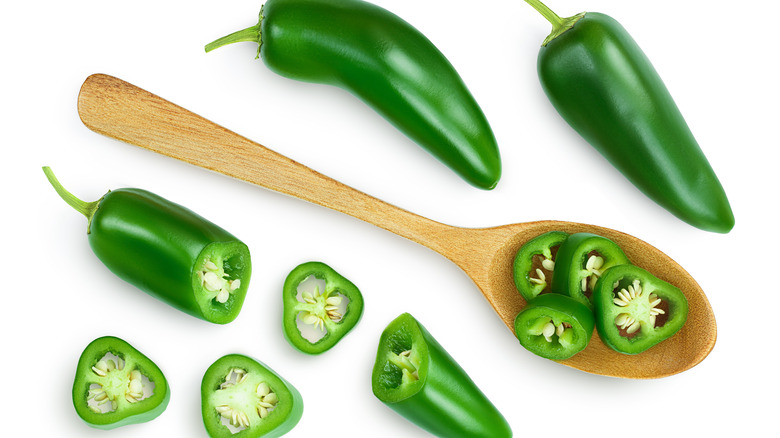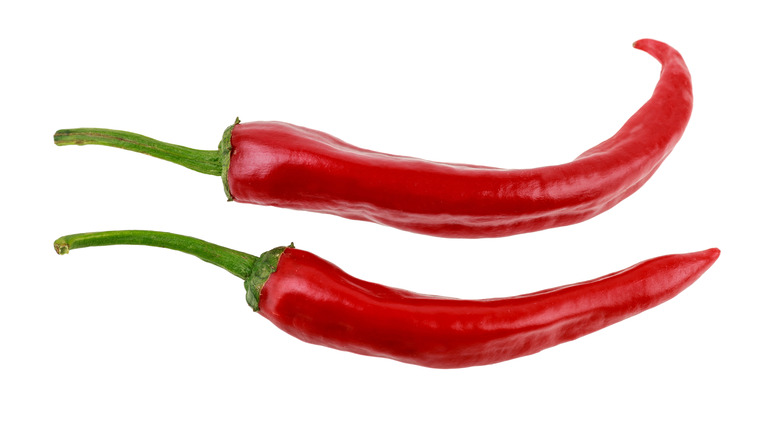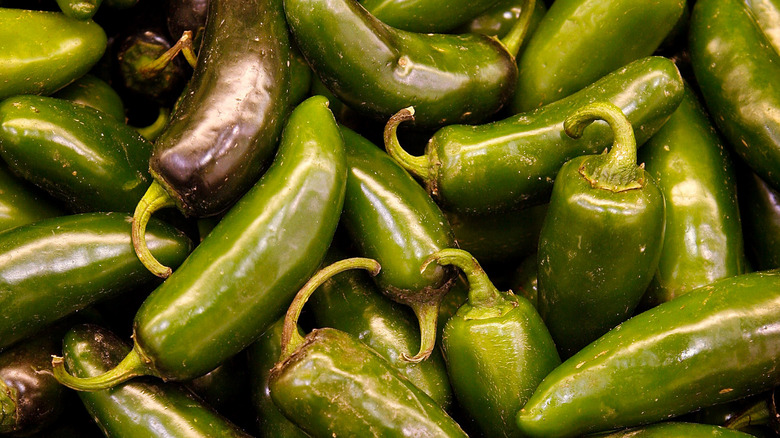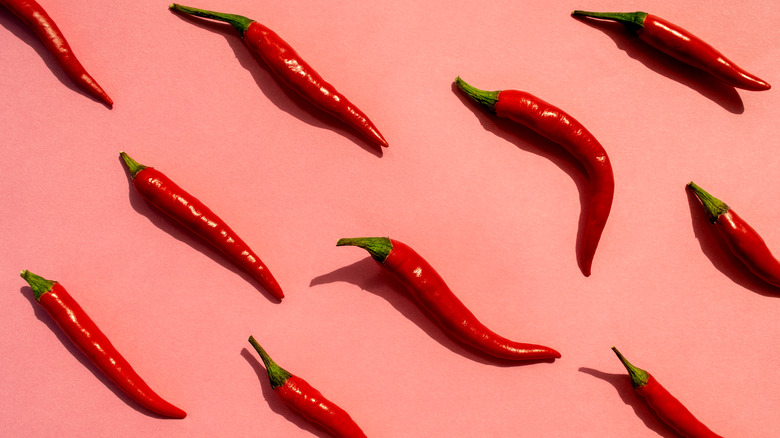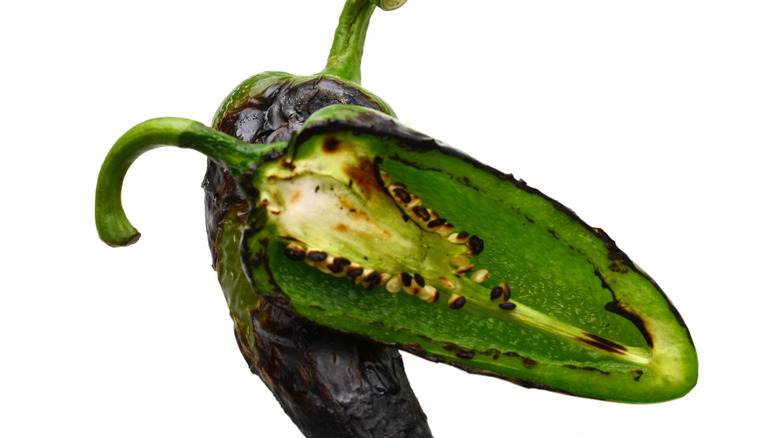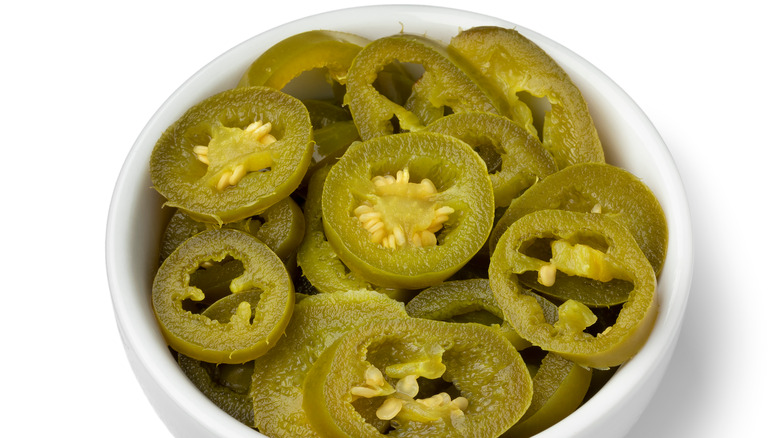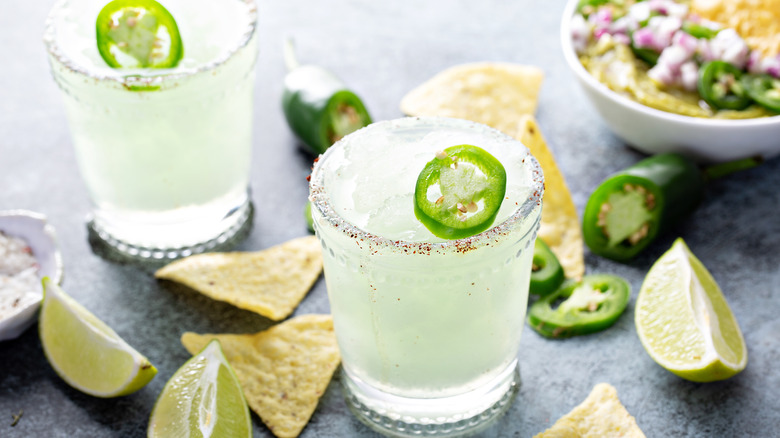What Is A Jalapeño Pepper And How Spicy Is It?
Who doesn't like a little spice in their life, even if it's just a little? According to a report by The Spruce Eats, the jalapeño is a medium-sized pepper with a moderate amount of spice. Nothing in comparison to something like a ghost pepper or Carolina reaper, but just enough to add a little glow to whatever needs some spicing up. These classic green and red chili peppers are said to hail from Xalapa, Mexico, where they get their name from.
Though jalapeños are actually part of the same family as tomatoes, it's the compound known as capsaicin that sets them and their hot pepper cousins apart. Jalapeños can vary in spice due to all the variables in which they're grown, but they typically hover around the bottom end of the Scoville scale, which measures the units of heat in spicy foods. So for those who like a little bit of a spicy glow on their tongue but don't want to lather it in milk after, jalapeños are a pretty safe bet.
What do they taste like?
Like almost any type of food, the taste of jalapeño will vary greatly depending on how you utilize it. While there are so many ways you can use this snappy little pepper — from different types of salsas and sauces to pickling them or turning them into poppers — the jalapeño itself can have two basic distinct flavors, depending on whether it's raw or roasted. Raw jalapeños are typically fresh and crisp feeling, something like a green bell pepper with a little bit of fire. But if you want even less heat than a raw jalapeño offers, there is an easy option available to you.
According to Our Everyday Life, you can take the edge off a jalapeño simply by roasting it. When you cook a hot pepper, the heat from the flames actually reduces the levels of capsaicin found in the skin of the pepper. On top of lower the amount of heat naturally found in the pepper, roasting it will transform that jalapeño freshness into a sweet and smoky flavor, vastly different from that of raw pepper.
Are there health benefits to eating jalapeños?
While there may be some drawbacks to chowing down on these little chilis, especially for those with an intolerance to heat, it looks like the advantages of jalapeño intake far outweigh the potential negatives. According to a writeup by Healthline, among the few possible negatives that come along with jalapeño consumption is that those already plagued with heartburn can find themselves even worse off after eating them. The same goes for those who suffer from irritable bowel syndrome. However, if you're lucky enough to have neither of these problems and you don't mind the spice, jalapeños have a vast array of benefits.
On top of being choc-full of vitamin C and vitamin B6, jalapeños offer a whole lot more than one might assume. Studies show that they may be able to fight cancer and various infections, promote weight loss in the abdominal area, and even curb your calorie intake. Maybe even more surprisingly, while one may have thought the complete opposite, jalapeños might actually be able to prevent stomach ulcers because of the chemical compound found in spicy foods. And while it may not be recommended to scoff down a 100% chili pepper diet, the advantages show just how beneficial they can be.
How spicy are jalapeños compared to other chilis?
While the jalapeño is one of the most well-known of the chili peppers, and chili peppers are best known for their spiciness, it's far from its kin when it comes to spice. As in, it will make you cry far less than the likes of ghost peppers or habaneros. According to Pepper Scale, the jalapeño rates nowhere near the likes of habanero on the Scoville scale. But what exactly is the Scoville scale?
Scoville Heat Units are used to measure the capsaicin levels in hot peppers. While something like a habanero will measure a maximum Scoville Heat Unit of 350,000, or the ghost pepper that maxes out at a whopping 1,041,427 SHU, the jalapeño tops out at 8,000, paling in comparison to some of the other most popular "hot" peppers out there. And that's simply calculating the maximum level of heat units, where the median remains around 5,250 SHU. So if you just prefer a little kick as opposed to a kick in the face, jalapeños might be the pepper for you.
Roasted jalapeños
Fresh jalapeños, despite not arriving very high on the Scoville scale, are far spicier when eaten fresh. Hence some people preferring to give their favorite chilis a nice little roasting over. Tori Avey provides two different methods to roll back some of that spice and give it a new smoky flavor to add to any number of dishes. You can go the broiler route, or if you have the time, you can use a gas stove to roast them.
Both methods are extremely simple and depend on what you have at hand. In order to make those jalapeños a little smokier via broiler, you need to preheat your oven, for starters. While the oven is preheating, remove the stems and cut the chilis down the middle so you can remove the seeds. Then simply let them roast on a baking pan with tin foil for three to four minutes, or until the skin becomes a charred-looking green. The other method, which has a bit more of a campfire vibe, simply requires you to stick your jalapeño onto a skewer and roast it over an open gas stove flame like it were a spicy green marshmallow. But these aren't the only ways to take some of that signature jalapeño zing back a little.
Pickling jalapeños
Another way to control the heat when it comes to jalapeños — or any chili pepper, for that matter — is to pickle them. According to Gimmie Delicious, pickling takes only a fraction of the time compared to jarring fresh jalapeños and will even last a lot longer on account of being stored in vinegar. But perhaps the best part of pickling your chilis is that it only takes about 20 minutes of prep time. Another plus is that they'll still be crunchy and fresh tasting with an added sweet and tangy aspect to them. For this particular recipe, you'll need some white vinegar, water, crushed cloves of garlic, salt, and sugar. Elsewhere, Andrew Zimmern uses a unique mixture of rice wine vinegar, salt, sugar, garlic, quartered shallot, lemon, and thyme. Whichever recipe you decide to go with, you'll have a jar's worth of pickled jalapeños to pop right into your fridge.
And you thought jalapeños were just for food...
Pickled, roasted, salsas, poppers. And you thought jalapeños were just a way to spice up your food. According to A Couple Books, there's another way to utilize these little chili peppers, especially for anyone who likes to dial the party up to eleven. Say goodbye to sugar and slices of lime and hello to dancing on tables. Ladies and gentlemen — the Jalapeño Margarita. With only four simple ingredients, this variation of the classic margarita is bound to add a little more spice to an already dangerous cocktail.
While it may be a recipe for destruction, at least it's a very simple one. Like any margarita, you want to rim the glass with salt to bring out the flavors. Then you simply add the tequila, Cointreau, sliced jalapeños, and lime juice to a cocktail shaker with a couple of ice cubes and, well, shake. Strain it into your glass and if you so please, you can add a couple more jalapeño slices to garnish it up a bit. And voila, your taco Tuesday just got crazy.
